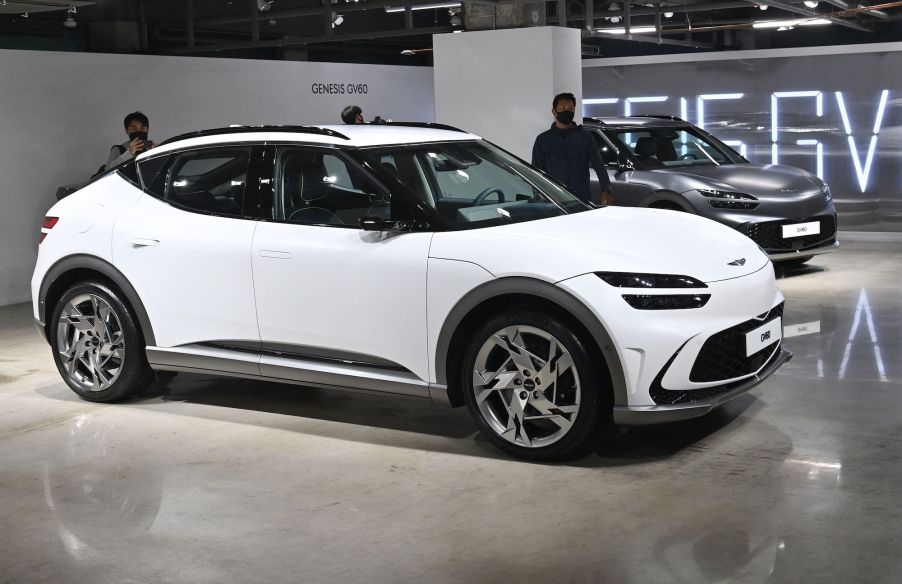
4 Reasons to Buy a 2023 Genesis GV60, Not a Jaguar I-Pace
In the last few years, the car market has seen an influx of new electric vehicles, with most automakers trying to carve out a piece of the EV market for themselves. Genesis Motors, Hyundai’s luxury division, is no different with its brand-new luxury entry: the Genesis GV60. But how does Genesis’ offering compare to other luxury EVs in the market? Here are four reasons to pick the 2023 Genesis GV60, not a Jaguar I-Pace.
The lower asking price

According to Genesis, the GV60 is technically available in three variants: the Advanced 2WD model, the Advanced AWD model, and the Performance AWD trim. However, Top Electric SUV also notes that availability in the U.S. is limited to AWD models for the Advanced and Performance trims.
As you’d expect from a luxury EV, pricing isn’t cheap, and the starting price is listed as $58,890 by Consumer Reports. That said, you pay more of a premium to own the Jaguar I-Pace, with its MSRP being $71,300. This is about $3,000 more than the GV60’s top-of-the-line Performance trim, which starts at $67,890. It’s also almost $12,500 more than you have to pay for the GV60’s Advanced trim.
Notably, the Jaguar electric SUV is eligible for tax credits so that buyers may save money on the recommended retail price. However, this doesn’t give it an advantage over the Genesis. The GV60 EV is also eligible for tax credits.
Lastly, despite the higher price, you’ll get more power with the GV60 Performance trim, which offers 429 hp compared to the Jaguar’s 394 hp.
Better fuel efficiency with the Genesis GV60
In addition to the lower starting price, you’re also likely to save more on fuel over time with the 2023 Genesis GV60 compared to the Jaguar I-Pace. This applies to the Advanced and Performance trims despite having different fuel efficiency ratings. The Advanced option is rated for 103 MPGe in the city, which drops to 86 MPGe on the highway for a combined 95 MPGe.
While not stellar by EV standards, 95 MPGe is significantly better than what you get with the 2022 Jaguar I-Pace, rated at a combined 76 MPGe by Consumer Reports. The website also lists the Jaguar’s city and highway gas mileage at 80 MPGe and 72 MPGe, respectively.
As for the GV60 Performance trim, some of the gas mileage is sacrificed for more horsepower and torque. That said, the 90 MPGe figure averaged 82 MPGe on the highway and 97 MPGe in the city. Still, that leaves the 2022 Jaguar I-Pace in the dust.
The Jaguar I-Pace doesn’t have as much driving range
Given the energy capacity in both electric SUVs, the Jaguar I-Pace has a significantly bigger battery than its Genesis counterpart. For context, the GV60’s battery capacity is 77.4 kWh, while the Jaguar I-Pace’s battery capacity stands at 90 kWh, according to Edmunds.
However, thanks to the fuel efficiency of the two electric vehicles, the GV60 burns through stored energy much slower, resulting in more range. In fact, the Advanced AWD model’s best-case scenario is driving 248 miles on a single charge.
Conversely, the lone remaining I-Pace trim for the 2022 model year, the HSE, can only manage 234 miles maximum. This is also one mile short of the Performance trim’s range.
The Genesis GV60’s wireless charging capabilities
Genesis is also a pioneer, with the automaker being the first to offer wireless charging for electric vehicles. The company has already launched three wireless EV charging stations in South Korea. It also plans to build more than 70 other stations in different locations.
The infrastructure has yet to reach the U.S. That said, GV60 buyers will be among the first to use it when it’s eventually unveiled. On the other hand, I-Pace owners are unlikely to use wireless charging for a long time.


